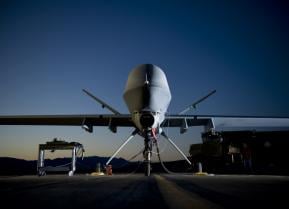A Huge Floating Drydock Sank and Nearly took Russia’s Only Aircraft Carrier with It
Officially, Moscow has assured the world that the refit of the Kuznetsov remains ‘on schedule’ after the PD-50 accident.
On October 30, Russia’s sole remaining aircraft carrier, the Admiral Kuznetsov, lay nested inside PD-50—a huge 330-meter long and 79-meter tall floating drydock currently moored off the Roslyakovo dockyard near the city of Murmansk. That morning, the dock suddenly began tilting to one side, causing personnel to scramble for safety. One of its tall, seventy ton cranes smashed into the Kuznetsov’s hull near the waterline, tearing a 3.5 by 4.5-meter-sized gash into its flank. The other crane fell into the water.
The Kuznetsov remained buoyant, however, and a tug hastily pried 47,000-ton carrier away from the floating drydock, which submerged completely under the water in four hours. Four workers were injured, and, tragically, one remains missing and is likely dead.
PD-50 now lies 160 feet below the water and will prove very difficult to resurface—in the unlikely event doing so is at all practical. Officially the accident has been attributed to a loss of electrical power in the dock’s water pumps, though it appears that illegal safety violations are implicated in the sinking, and that a legal battle is in the works. Reporter Ilya Kramnik wrote in Izvestiya that the Kuznetsov nearly sank with the dock to lacking her own independent power, and that the dockyard had cut costs on electrical maintenance personnel and diesel generators.
This the first accident on PD-50 in recent memory: the submarine Yekaterinburg caught fire on PD-50 in 2011 while loaded with nuclear missiles and had to be flooded twice to put out the blaze.
PD-50 was nonetheless the largest floating drydock in Russia, and the only extra large one serving Russia’s Northern Fleet—home to the better part of Moscow’s critical ballistic missile submarine force. In fact, those huge nuclear-powered subs made very heavy use of PD-50. While some shore-based drydocks are available, of course, transferring ships into them takes a lot longer, and vessels currently being worked on can’t be quickly swapped out.
PD-50 was also uniquely of an appropriate size to help refurbish the Russian Navy’s huge nuclear powered battlecruisers—particularly the Pyotr Veliki, which was scheduled to undergo renovation soon.
As a result, the drydock sinking may significantly impair the Russian Navy’s submarine, cruiser and carrier operations, and particularly its efforts to modernize its larger, older platforms.
Russia does maintain a few other large floating drydocks that can accommodate its ballistic-missile subs—though probably not the larger Admiral Kuznetsov. Two other drydocks in the Black Sea measures roughly 300 and 250 meters long, but are considerably narrower. The Japanese-built PD-41, which services the Pacific Fleet in the Russian Far East, may be large enough but is quite distant.
These drydocks could only be towed across to the Northern Fleet slowly, at great expense and at some risk of mishap during transit through icy waters ad narrow straits. Of course, moving them would deny those other bases their vital services.
Nor can PD-50 be easily replaced, as it was purchased from Sweden. Given current tensions and sanctions imposed on Moscow, a new purchase from any European source is currently unlikely. The Soviet Union formerly relied heavily on the Ukrainian Mykolaiv shipyards for carrier construction—in fact, China’s first aircraft carrier is a Kuznetsov sistership purchased from Ukraine—but Kiev is unlikely to assist Moscow given Russia’s invasion of Crime and eastern Ukraine. East Asian shipyards would have few qualms, but a replacement would still take years to produce and would still need to be transited over a long distance to Severomorsk.
The Kuznetsov—technically a missile-armed ‘aircraft-carrying cruiser’ for political reasons related to access to the Bosporous strait—famously sailed to the Mediterranean coast of Syria late in 2016 to launch carrier-based MiG-29K and Su-33 fighters off its ski-jump deck into combat for the first time in the Russian Navy’s history. Meant to build-up Moscow’s prestige, the deployment instead highlighted the Russian Navy’s inexperience with carrier operations when malfunctions with its arrestor systems caused two of her jets to crash into the sea (one actually ran out of fuel waiting for the crew to fix a malfunction). The Kuznetsov’s turbo-pressurized boilers were already infamous for suffering frequent breakdowns, requiring the carrier to be constantly escorted by a large tug.
Recommended: Imagine a U.S. Air Force That Never Built the B-52 Bomber
Recommended: Russia's Next Big Military Sale - To Mexico?
Recommended: Would China Really Invade Taiwan?
After just two months on its ill-starred Syrian venture, the Kuznetsov retired to Severeomorsk to begin an $800 million-dollar (50 billion ruble) refit and modernization planned to last four years—grounding the Russian Navy’s carrier aviation branch for that entire span, which will not do any favors to the retention of experienced personnel. However, in October 2018, the money allocated to the refit was cut in half, with upgrades to sensor, communication and defensive systems likely curtailed in order to replace the notoriously faulty boilers.
Officially, Moscow has assured the world that the refit of the Kuznetsov remains ‘on schedule’ after the PD-50 accident. Given Russia’s lack of candor about past naval accidents, most experts believe the trouble-prone carrier’s refit will at the very least suffer significant delays, if the “accident” doesn’t call into question the money invested in the arguably largely symbolic capabilities provided by the Kuznetsov.
Sébastien Roblin holds a master’s degree in conflict resolution from Georgetown University and served as a university instructor for the Peace Corps in China. He has also worked in education, editing and refugee resettlement in France and the United States. He currently writes on security and military history for War Is Boring.
Image: Creative Commons.


